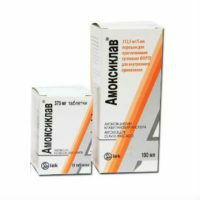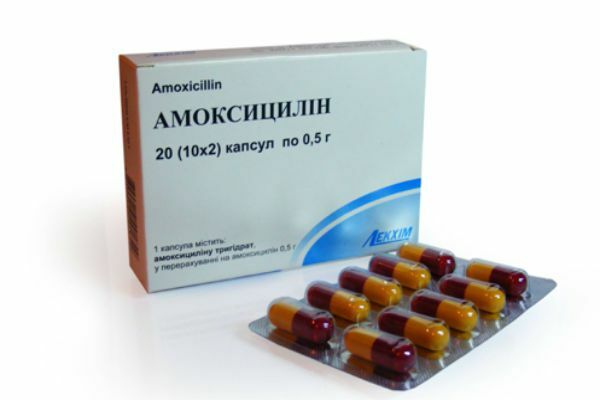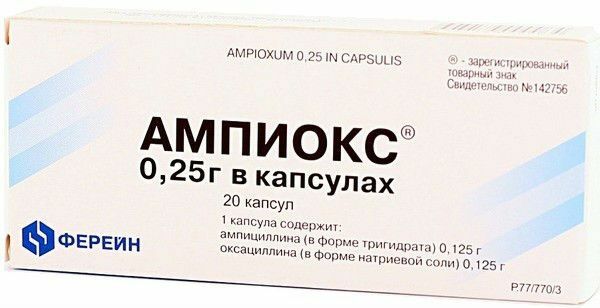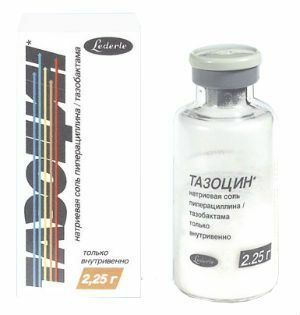
Amoxiclav is an antibacterial preparation of the penicillin group. This is a complex tool of a new generation, which has powerful antimicrobial activity against most pathogenic bacteria. Thanks to this, the drug has a wide range of uses, and is successfully used to treat many diseases. Read more about Amoxiclav, the forms of its release, from which it helps, side effects and contraindications.
- composition and action
- issuance
- Indications
- use How to take
- Tablets
- Tablets Amoxiclav Kviktab
- Powder for parenteral use
- suspension
- Contraindications
- Side effects
- during pregnancy
- For
- Children With alcohol
- Analogs
- Amoxicillin( AmoxicillinSandoz, Amosin, Ecobol, Ranoxil)
- Ampiox( Oxampicin, Oxamp)
- Ammiside( Sultasin, Sulacillin, Libacilum, Ampicillin + Sulbactam, Sulbacin)
- Clonakm-X
- tazocin( Tazrobida, piperacillin + tazobactam Teva)
- Timentin
composition and action
main active substance - amoxicillin and clavulanic acid. The combination of these active substances provides a pronounced therapeutic effect of the antibiotic. Thanks to clavulanic acid Amoxiclav can be prescribed for infections resistant to the action of amoxicillin.
Antibacterial drug has a pronounced bactericidal and bacteriostatic effect on virtually all types of streptococci( except - methicillin-resistant strains), listeria, echinococcus. Gram-negative bacteria are also sensitive to the drug: klebsiella, brucella, moraxella, salmonella, gardnerella, proteus, clostridium and others.
The maximum concentration of the antibiotic is reached after 1 hour after taking the drug. The active substances, regardless of the method of administration, are quickly distributed in the tissues and body fluids( middle ear, lungs, uterus, ovaries, peritoneal and pleural fluids, fat and muscle tissues, sinus sinuses, tonsils and so on).
The drug is excreted from the body through the kidneys( half-life with healthy kidneys - 1-1.5 hours).A small amount of metabolites of clavulanic acid is released with exhaled air and caloric masses.
The drug does not penetrate the brain shell and cerebrospinal fluid, this feature significantly reduces the risk of unpleasant side effects from the CNS.
to contents ^Forms of release
- Amoxiclav tablets - 250 milligrams of amoxicillin / 125 milligrams of clavulanic acid, 500 milligrams / 125 milligrams and 875 milligrams / 125 milligrams, respectively;
- Amoxiclav Quicact Tablets - 500 milligrams / 125 milligrams, 875 milligrams / 125 milligrams, dispersed tablets;
- Amoxiclav for parenteral administration - a powder for the preparation of a solution for the administration of a vein of 600 milligrams( 500 milligrams of amoxicillin and 100 milligrams of clavulanic acid) or 1.2 grams in a vial( 1000 milligrams of amoxicillin and 200 milligrams of clavulanic acid);
- powder for the preparation of the suspension is 125 milligrams of amoxicillin and 31.25 milligrams of clavulanic acid per 5 milliliters and 250 milligrams of amoxicillin and 62.5 milligrams of clavulanic acid per 5 milliliters.
Indications for use
- Infections of ENT organs and infectious diseases of the upper respiratory tract( retropharyngeal abscess, pharyngitis, scarlet fever, otitis media, tonsillitis, sinusitis, chronic and acute sinusitis, laryngitis, tracheitis, tonsillitis).
- Infections of the lower respiratory tract( bronchitis chronic and acute, pneumonia).
- Biliary tract infections( cholangitis, cholecystitis).
- Urinary tract infections( cystitis, prostatitis, pyelonephritis, urethritis and others).
- Gynecological diseases of infectious origin( adnexitis, inflammation of appendages, endometritis and others).
- Odontogenic infections, including periodontitis.
- Venereal infections( syphilis, ureaplasma, gonorrhea, including gonorrhea provoked).
- Shankroid.
- Infections of soft tissues and skin, including wound infections( furunculosis and so on).
- Infections of the joints and bones.
- Orthopedic practice.
- Infections of the lymphatic system( lymphadenitis and others).
- Mixed infections that are caused by gram-negative and gram-positive microorganisms, anaerobic pathogens( mammary abscess, mastitis, postoperative abdominal infections, aspiration pneumonia).
Also Amoxiclav is used in dentistry( with flux, stomatitis and so on) and for the prevention of purulent-septic complications during surgical interventions on the organs of the abdominal cavity, small pelvis, kidneys, bile ducts, cardiac muscle.
How to take
The exact dosage regimen is set by the doctor individually, depending on the severity of the disease and the therapeutic effect. The duration of antibiotic treatment is from 5 to 14 days.
to table of contents ^Tablets
Take in directly before meals, swallowing whole, not liquid and squeezed with water.
According to the instructions, adults and children with a body weight above 40 kilograms for pathologies of mild and moderate severity are prescribed 1 tablet( 250 milligrams / 125 milligrams) every 8 hours( 3 times per day) or 1 tablet( 500/125 milligrams) every12 hours( 2 times a day);with a severe form of the disease prescribed - 1 tablet of 500 milligrams / 125 milligrams every 8 hours( three times per day) or 1 tablet of 875 milligrams / 125 milligrams every 12 hours( twice a day).
to table of contents ^Tablets Amoxiclav Kviktab
Before use, the tablet must be dissolved in 100-150 milliliters of water and mixed well. Adults and children from 12 years of age are prescribed 1 tablet( 500 milligrams / 125 milligrams) 2-3 times a day;in severe conditions - 1 tablet( 875 milligrams / 125 milligrams) twice a day.
to contents ^Powder for parenteral use
To prepare the solution for intravenous administration, the contents of the vial are dissolved in water for injection( for Amoxiclav 600 milligram - 10 milliliters, for Amoxiclav 1.2 grams - 20 milliliters).Further, the resulting solution is administered intravenously slowly for 4-5 minutes.
If the drug is to be administered as an intravenous infusion, then 600 milligrams of the drug is dissolved in 10 milliliters of water for injection and added to the infusion solution( 50 milliliters).Antibiotic 1.2 grams is dissolved in 20 milliliters of water for injection and added to 100 milliliters of infusion solution. Drip the drug for 30-40 minutes. Do not freeze the product.
Suspension
Flask with powder well shake, add warm boiled water( up to the mark) in 2 sets, shaking each time until the powder is completely dissolved.
In pediatrics, newborns and infants under 3 months are prescribed a medicine at the rate of 30 milligrams per kilogram of weight( daily dose), this amount should be divided and given in 2 divided doses at regular intervals.
Since 3 months, the antibiotic is prescribed at a dose of 25 milligrams per kilogram of body weight, it is also divided equally into 2 divided doses. For infectious diseases of moderate severity, 20 milligrams per kilogram of body weight are prescribed and divided into 3 injections. In severe conditions, the dose is increased - 45 milligrams per kilogram of weight and divided into 2 injections per day.
to the table of contents ^Contraindications
- Lymphatic leukemia;
- infectious mononucleosis;
- cholestatic jaundice or hepatitis caused by antibacterial drugs of the penicillin group;
- hypersensitivity to antibiotics of the group of cephalosporins, penicillins and other beta-lactam drugs;
- increased sensitivity to clavulanic acid or amoxicillin.
With care, the drug is prescribed for severe violations of kidney function, kidney failure and patients with pseudomembranous colitis in history.
Side effects of
- Allergic reactions : urticaria, itching, erythematous rash;in rare cases - angioedema, allergic vasculitis, anaphylactic shock, Stevens-Johnson syndrome, exfoliative dermatitis.
- From the digestive tract : nausea, loss of appetite, diarrhea, vomiting;rarely - pain in the abdomen, violations of the liver;in isolated cases, hepatitis, cholestatic jaundice, pseudomembranous colitis can develop.
- From the nervous system : headache, dizziness;rarely - hyperactivity, insomnia, anxiety, convulsions( can be observed in patients with impaired renal function when using the drug in high doses).
- On the part of the hematopoiesis system : cases of reversible leukopenia( including neutropenia), thrombocytopenia are rare;in isolated cases, hemolytic anemia, pancytopenia, eosinophilia, reversible increase in prothrombin time( with simultaneous use with anticoagulants).
- From the side of the urinary system : rarely - crystalluria, interstitial nephritis.
- Other : Candidiasis.
When pregnant
Antibacterial drug is not recommended for use during pregnancy. Exceptions are cases where the benefit of the treatment is higher than the potential harm to the fetus. Taking Amoxiclav during pregnancy increases the risk of developing necrotizing colitis in newborns.
It is undesirable to take the drug and lactation, as clavulanic acid and amoxicillin in small amounts excreted in breast milk. If the mother still prescribed treatment with a medicine, it is necessary to cancel breastfeeding for a while. Otherwise, the child may experience diarrhea, allergic reactions and so on.
to the table of contents ^For children
For children under 12 years and weighing less than 40 kg, an antibiotic in the form of a suspension is prescribed. Recommended dosages are indicated above.
to the table of contents ^With alcohol
It is prohibited to drink alcoholic beverages during drug therapy. Drinking alcohol significantly reduces the antibacterial effect of the drug and makes it difficult to remove through the kidneys.
to contents ^Analogs
Substitutes for active ingredient: Amovicomb, Arlet, Augmentin, Amoxicillin + Clavulanic acid, Bactoklave, Verklav, Clamosar, Lyclav, Medoclave, Panklave, Ranklave, Rapiklav, Taromentin, Flemoclav Solutab, Ecoclave.
Analogues on the mechanism of action:
to the table of contents ^Amoxicillin( Amoxicillin Sandoz, Amosin, EcoBall, Ranoxil)

Form release - tablets, capsules, powder for injection, suspension;active ingredient is amoxicillin.
A bactericidal antibacterial agent from the group of semisynthetic penicillins. It has a wide spectrum of action and is used to treat bacterial infections: pneumonia, bronchitis, angina, urethritis, pyelonephritis, gonorrhea and other caused by microorganisms that are sensitive to the drug.
Dosage is selected individually. For admission to adults and children with 12 years( or weighing more than 40 kilograms) appoint 250-500 milligrams, with a serious course of the disease - up to 1 gram;children 5-10 years - 250 milligrams;2-5 years - 125 milligrams;up to 2 years, the daily dose is 20 milligrams per kilogram of weight. Between the drug intake should take at least 8 hours. Children under 12 years of age are recommended to use Amoxicillin in the form of a suspension.
For parenteral use, adults are given intramuscularly 1 gram twice daily;children - 50 milligrams / kilogram / day, single - 500 milligrams, the frequency of administration - 2 times a day.
Side effects: erythema, Quincke's edema, conjunctivitis, anaphylactic shock, joint pain, febrile condition.
Ampiox( Oxampicin, Oxamp)

Form release - capsules, powder for solution preparation;active substances - ampicillin sodium, oxacillin sodium.
Antibacterial drug refers to semi-synthetic penicillins and is active against gram-negative( meningococcus, Escherichia coli, gonococcus, salmonella, etc.) and Gram-positive( streptococcus, pneumococcus, staphylococcus) microorganisms. Indications for use are: tonsillitis, pyelonephritis, sinusitis, tonsillitis, pneumonia, otitis media, meningitis, cystitis, cervicitis and so on.
Capsules are taken orally before meals, swallowing whole and with water. Adults and adolescents from age 14 are prescribed 0.5-1.0 grams( 2-4 capsules);7-14 years - 50 milligrams / kilogram / day;3-7 years - at 100 milligrams / kilogram / day;The daily dose is divided into 4-6 receptions. The duration of treatment is 7-14 days.
Intravenous and intramuscular( drip, jet) daily dose for adults and adolescents from 14 years is 3-6 grams;children 7-14 years - 100 milligrams / kilogram / day;1-6 years - 100 milligrams / kilogram / day;newborns, premature babies and toddlers under 1 year - 100-200 milligrams per kilogram / day. The daily intake should be administered in 3-4 sessions, with an interval of 6-8 hours. According to the indications, the doses can be increased by 1.5-2 times.
Side effects: rhinitis, skin flushing, arthralgia, conjunctivitis, vomiting, diarrhea, nausea, lakopenia, enterocolitis, anemia, angioedema.
Ammiside( Sultasin, Sulacillin, Libacilum, Ampicillin + Sulbactam, Sulbacin)

Form of release - powder, tablets;active substances - ampicillin, sulbactam.
The combination antibiotic of the penicillin group is prescribed to patients of all age groups in infectious diseases caused by susceptible to ampicillin and sulbactam, microorganisms. Among them are: respiratory organs( pleurisy, bronchitis, bacterial pneumonia), ENT organs( otitis, sinusitis, tonsillitis), urinary and genital system( cystitis, pyelonephritis, adnexitis, etc.), gastrointestinal tract( cholangitis, pancreatitis, cholecystitis), musculoskeletal system( myositis, arthritis, osteomyelitis), skin and subcutaneous tissue( burn wounds, erysipelas, infected dermatoses), prevention of postoperative infections.
Tablets are prescribed inside before meals, for 1-2 hours at a daily dose of 375-750 milligrams for adults and 25-50 milligrams per kilogram of body weight for children whose weight does not exceed 30 kilograms. The daily dose of the drug should be divided into 2 divided doses.
Intramuscularly and intravenously( drip at a speed of 60-80 drops per minute, jet - slowly, for 3-4 minutes).Intravenously injected for 5-7 days, if you need to continue treatment, then switch to intramuscular use. With an easy flow of infection, adults - 1.5-3 grams per day in 2 injections;at the average flow - 3-6 grams per day in 3-4 injections;heavy current - 12 grams per day in 3-4 injections. To children, the daily dose is taken at the rate of 150 milligrams per kilogram of weight, the frequency of administration is 3-4 times;Newborn and premature babies - every 12 hours. The duration of therapy is 5-14 days.
Side effects: decreased appetite, nausea, vomiting, diarrhea, anemia, leukopenia, drowsiness, headache, skin flushing, hives, rhinitis, eosinophilia, candidiasis( with prolonged use).
Clonak-X
Form release - capsules;active substances - amoxicillin trihydrate, cloxacillin sodium.
The drug is active against most Gram-positive and Gram-negative bacteria. It is prescribed for infections of the upper respiratory tract, pneumonia, bronchitis, infection of the gastrointestinal tract, urinary tract, skin and soft tissue, gonorrhea and so on.
Capsules are taken before meals, washed down with water, swallowing whole, without chewing. Adults are prescribed 1 capsule every 6-8 hours, depending on the severity of the disease. If the renal function is impaired, the dose is reduced.
Side effects: nausea, diarrhea, skin rashes, in rare cases, may develop pseudomembranous colitis( intestinal colic).
Contraindications: child age, pregnancy, lactation, infectious mononucleosis, hypersensitivity to active substances. Take with caution patients with allergic reactions.
to table of contents ^Tazocine( Tazrobid, Piperacillin + Tazobaktam Teva)

Form release - lyophilizate for solution;active substances - piperacillin, tazobactam.
Bactericidal semisynthetic antibacterial agent of a wide spectrum of action is effective for infections of moderate and severe course: bacterial infections of the lower and upper respiratory tract, abdominal organs, complicated and uncomplicated pathologies of the skin and soft tissues, abscess, pelvic organs, bacterial septicemia( bacterial contamination of the blood), infections of joints and bones.
The drug is administered intravenously drip( slowly for 30 minutes) or intramuscularly. The daily dose for adults and adolescents with 12 years of age with normal renal function is 2.25 grams every 6 hours or 4.5 grams every 8 hours;children 2-12 years old - 90 milligrams per kilogram of weight every 6 hours. For patients undergoing hemodialysis( blood cleansing method), the maximum dose is 2.25 grams every 8 hours. The duration of therapy is 7-10 days.
Side effects: vomiting, nausea, development of intestinal colic, pruritus, urticaria, rashes, erythema, headache, convulsions, hypoglycemia, phlebitis, hypotension, flushing of the skin to the skin of the face, fever, rarely - arthralgia and others.
Timentin
Form release - lyophilizate for solution preparation;active ingredients - ticarcillin, clavulanic acid.
The antibiotic has a wide spectrum of action and is indicated for the treatment of infections of connective and bone tissue, in gynecology, skin and subcutaneous tissue, urinary tract and so on.
The drug is administered intravenously by drip or jet. Intervals between infusions should be at least 4 hours. Therapy should be continued for 48-72 hours after the disappearance of the symptoms.
Adults and adolescents weighing more than 40 kilograms average dose is 3 grams every 6 hours or 5 grams every 8 hours. The maximum dose is 3 grams every 4 hours. Children weighing less than 40 kilograms are prescribed 75 milligrams / kilogram every 8 hours( maximum - 75 milligrams every 6 hours);premature babies weighing less than 2 kilograms - 75 milligrams every 12 hours, weighing more than 2 kilograms - 75 milligrams every 8 hours. In case of violations of kidney function, the dose is adjusted.
Side effects: diarrhea, nausea, vomiting, hepatitis, cholestatic jaundice, convulsions, leukopenia, decreased hemoglobin, eosinophilia, urticaria, rashes, itching, anaphylactic reactions, redness of the skin, burning sensation and so on.
